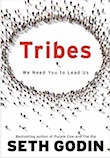
If you’re not following Seth at his blog, you might want to check it out. He seems to understand how our 2.0 World operates (or at least he often captures how the Divine DNA in social processes works). Here’s his thots on Micromovements from his excellent book, Tribes.
This is the heart of the matter: every leader cares for and supports a movement. A movement like the free speech movement at Berkeley or the democracy movement in Tiananmen Square or the civil rights movement in Mississippi. Or maybe a movement like the obsession with hand-roasted coffee in Brooklyn or the worldwide collection of people obsessed with tattoos.
Today, you can have a narrow movement, a tiny movement, a movement in a silo. Your movement can be known by ten or twenty or a thousand people, people in your community or people around the world. And most often, it can be the people you work with or for, or those who work for you.
The Web connects people. That’s what it does. And movements take connected people and make change.
What marketers and organizers and people who care are discovering is that they can ignite a micromovement and then be propelled by the people who choose to follow it.
The key elements in creating a micromovement consist of five things to do… and six leadership principles.
Five Things to Do
1. Publish a manifesto.
Give it away and make it easy for the manifesto to spread far and wide. It doesn’t have to be printed or even written. But it’s a mantra and a motto and a way of looking at the world. It unites your tribe members and gives them a structure.
2. Make it easy for your followers to connect with you.
It could be as simple as visiting you or e-mailing you or watching you on television. Or it could be as rich and complex as interacting with you on Facebook or joining your social network on Ning.
3. Make it easy for your followers to connect with one another.
There’s that little nod that one restaurant regular gives to another recognized regular. Or the shared drink in an airport lounge. Even better is the camaraderie developed by volunteers on a political campaign or insiders involved in a new product launch. Great leaders figure out how to make these interactions happen.
4. Realize that money is not the point of a movement.
Money exists merely to enable it. The moment you try to cash out is the moment you stunt the growth of your movement.
5. Track your progress.
Do it publicly and create pathways for your followers to contribute to that progress.
Six Leadership Principles
Principles
1. Transparency is the only option
2. Your movement needs to be bigger than you
3. Movements that grow, thrive
4. Movements are made most clear when compared to the status quo or to movements that work to push the other direction i.e. when they are noticebly different, not the same as another movement
5. Exclude outsiders (a powerful force is who is not part of the movement)
6. Tearing others down is never to a movement as helpful as building followers up
Leadership is not about you, it’s about the people around you. It’s about driving a movement forward, and building a community around it.
Leadership is stepping up because no one else is.
Excerpted from TRIBES: WE NEED YOU TO LEAD US by Seth Godin, by arrangement with Portfolio, a member of Penguin Group (USA), Inc. Copyright (c) Do You Zoom, Inc., 2008.
Leave a Reply